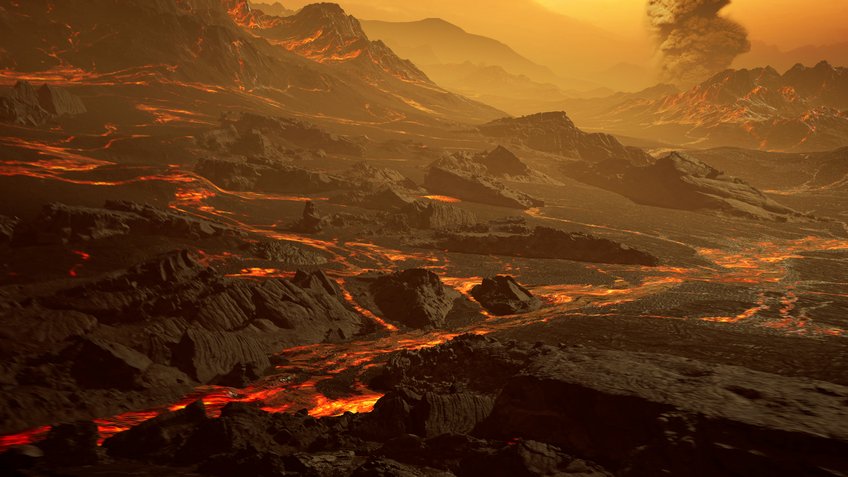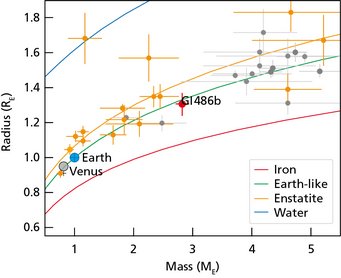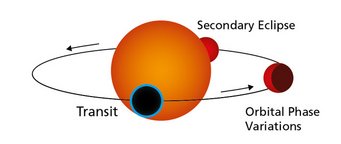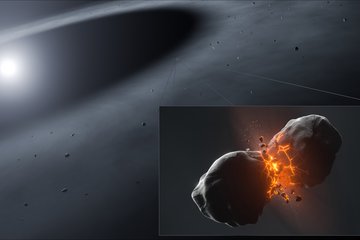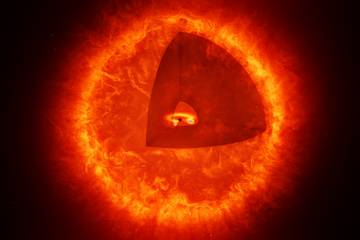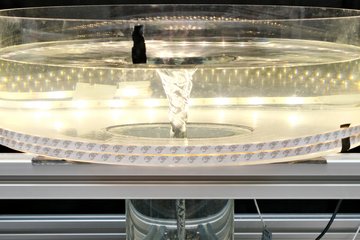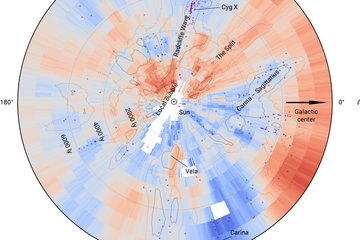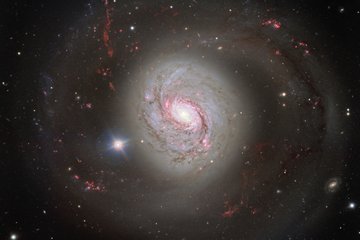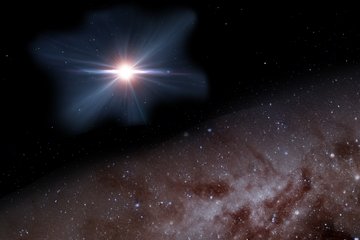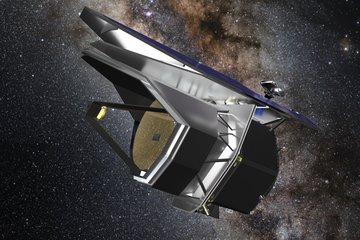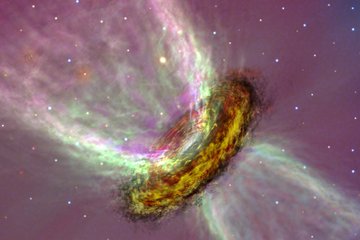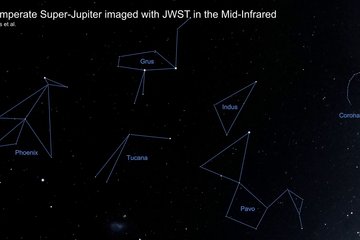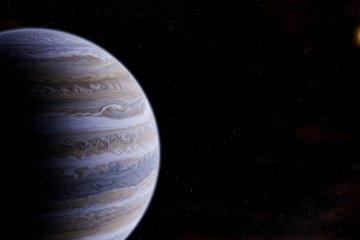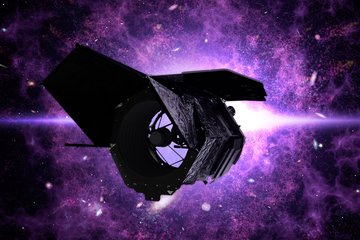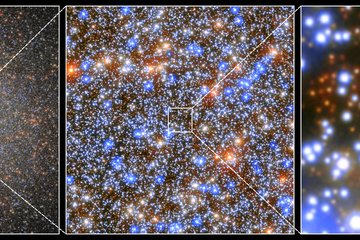A blazing nearby super-Earth
A hot super-Earth in our neighbourhood promises to be a suitable candidate to test rocky planet atmosphere models.
During the recent two and a half decades, astronomers have discovered thousands of exoplanets made of gas, ice and rock. Only a few of them are Earth-like. However, probing their atmospheres with the currently available instrumentation is challenging at best. Now, astronomers of the CARMENES consortium have published a new study, led by Trifon Trifonov from the Max Planck Institute for Astronomy, which reports the discovery of a hot rocky super-Earth orbiting the nearby red dwarf star Gliese 486. Despite its small separation from the parent star, the planet designated Gliese 486b possibly has retained a part of its original atmosphere. Therefore, Gliese 486b is uniquely suited to examine its atmosphere and interior with the next generation of space-borne and ground-based telescopes. The results are published in the journal Science today.

With the advent of efficient exoplanet-hunting facilities, the numbers of newly discovered worlds outside the Solar System quickly rose to thousands. By combining different observing techniques, astronomers have determined planetary masses, sizes, and even bulk densities, allowing them to estimate their internal composition. The next goal to fully characterize those exoplanets similar to Earth by studying their atmospheres is much more challenging. Especially for rocky planets like Earth, any such atmosphere consists of a thin layer, if it exists at all. As a result, many current atmospheric models of rocky planets remain untested.
Planetary atmospheres must meet specific prerequisites to observe them with next-generation observatories. At a distance of only 26 light-years, scientists of the CARMENES (Calar Alto high-Resolution search for M dwarfs with Exoearths with Near-infrared and optical Échelle Spectrographs) consortium now have found a planet orbiting the red dwarf star Gliese 486 that perfectly satisfies these specifications for rocky planets. The newly discovered planet designated Gliese 486b is a super-Earth with a mass 2.8 times that of our home planet. It is also 30% bigger than Earth. The scientists employed both transit photometry and radial velocity spectroscopy to obtain their results.
“The proximity of this exoplanet is exciting because it will be possible to study it in more detail with powerful telescopes such as the upcoming James Webb Space Telescope and the future Extremely Large Telescopes,” Trifon Trifonov explains. He is a planetary scientist at the Max Planck Institute for Astronomy (MPIA) and lead author of the article that features this discovery.
By calculating the planet’s mean density from the mass and radius measurements, its composition appears similar to Venus and Earth, including a metallic core. Anyone standing on Gliese 486b would feel a gravitational pull that is 70% stronger than what we experience on our world.

Gliese 486b revolves around its host star on a circular trajectory within 1.5 days and at a distance of 2.5 million kilometres. One rotation takes the same amount of time, so one side always faces the star. Although the star Gliese 486 is much fainter and cooler than the Sun, the irradiation is so intense that the planet’s surface heats up to at least 700 Kelvin (approx. 430 °C). In this sense, Gliese 486b’s surface probably looks more like Venus than Earth, with a hot and dry landscape interspersed with glowing lava rivers. However, unlike Venus, Gliese 486b possibly only has a tenuous atmosphere if any. Model calculations may be consistent with both scenarios because stellar irradiation tends to evaporate atmospheres. At the same time, the planet’s gravity helps to retain it. Figuring out the balance of those contributions is difficult.
“The discovery of Gliese 486b was a stroke of luck. A hundred degrees hotter and the planet’s entire surface would be lava. Its atmosphere would consist of vapourised rocks,” José A. Caballero of the Centro de Astrobiología (CSIC-INTA, Spain) and co-author of the paper concludes. “On the other hand, if Gliese 486b were a hundred degrees colder, it would have been unsuitable for follow-up observations.”
The future measurements that the CARMENES team have in mind exploit the orbital orientation, which causes Gliese 486b to cross the surface of the host star from our point of view. Whenever this happens, a tiny fraction of the stellar light shines through the thin atmospheric layer before it reaches Earth. The various compounds absorb light at specific wavelengths, leaving their footprint in the signal. By using spectrographs, the astronomers split up the light according to wavelengths and look for absorption features to derive the atmospheric composition and dynamics. This method is also known as transit spectroscopy.

A second spectroscopic measurement, called emission spectroscopy, is planned when parts of the illuminated hemisphere become visible like lunar phases during Gliese 486b’s orbit until it vanishes behind the star. The spectrum contains information on the bright, hot planetary surface.
“We can hardly wait for the new telescopes to become available,” Trifonov admits. “The results will help us to understand how well rocky planets can hold their atmospheres, what they are made of and how they influence the energy distribution on the planets.”
Both Trifonov and Caballero collaborate in the CARMENES project, whose consortium comprises eleven research institutions in Spain and Germany. Its purpose is to monitor some 350 red dwarf stars for signs of low-mass planets using a spectrograph mounted at the 3.5 m Calar Alto telescope (Spain). This study includes additional spectroscopic measurements to infer Gliese 486b’s mass. The scientists obtained observations with the MAROON-X instrument at the 8.1 m Gemini North telescope (USA) and retrieved archival data from the 10 m Keck telescope (USA) and the ESO 3.6 m telescope (Chile).
Photometric observations to derive the planet’s size stem from the TESS (Transiting Exoplanet Survey Satellite) spacecraft (NASA, USA), the MuSCAT2 (Multicolour Simultaneous Camera for studying Atmospheres of Transiting exoplanets 2) instrument mounted at the 1.52 m Telescopio Carlos Sánchez at Observatorio del Teide (Spain), and the LCOGT (Las Cumbres Observatory Global Telescope), among others.
Background information
The team was composed of T. Trifonov (Max-Planck-Institut für Astronomie [MPIA]), J. A. Caballero (Centro de Astrobiología [CAB]), J. C. Morales (Institut de Ciències de l'Espai [ICE] and Institut d’Estudis Espacials de Catalunya [IEEC-CSIC]), A. Seifahrt (The University of Chicago), I. Ribas (ICE/IEEC-CSIC), A. Reiners (Institut für Astrophysik, Georg-August-Universität Göttingen [Uni Göttingen]), J. L. Bean (The University of Chicago), R. Luque (Instituto de Astrofísica de Canarias [IAC] and Universidad de La Laguna [ULL]), H. Parviainen (IAC/ULL), E. Pallé (IAC/ULL), S. Stock (Zentrum für Astronomie der Universität Heidelberg [ZAH]) , M. Zechmeister (The University of Chicago), P. J. Amado (Instituto de Astrofísica de Andalucía [IAA-CSIC]), G. Anglada-Escudé (ICE/IEEC-CSIC), M. Azzaro (Centro Astronómico Hispano-Alemán [CAHA]), T. Barclay (NASA Goddard Space Flight Center, and University of Maryland), V. J. S. Béjar (IAC/ULL), P. Bluhm (ZAH), N. Casasayas-Barris (IAC/ULL), C. Cifuentes (CAB), K. A. Collins (Center for Astrophysics, Harvard & Smithsonian [CfA]), K. I. Collins (George Mason University), M. Cortés-Contreras (CAB), J. de Leon (The University of Tokyo), S. Dreizler (Uni Göttingen), C. D. Dressing (University of California at Berkeley), E. Esparza-Borges (IAC/ULL), N. Espinoza (Space Telescope Science Institute), M. Fausnaugh (Massachusetts Institute of Technology [MIT]), A. Fukui (The University of Tokyo), A. P. Hatzes (Thüringer Landessternwarte Tautenburg), C. Hellier (Keele University), Th. Henning (MPIA), C. E. Henze (NASA Ames Research Center), E. Herrero (ICE/IEEC-CSIC), S. V. Jeffers (Uni Göttingen), J. M. Jenkins (NASA Ames Research Center), E. L. N. Jensen (Swarthmore College), A. Kaminski (ZAH), D. Kasper (The University of Chicago), D. Kossakowski (MPIA), M. Kürster (MPIA), M.Lafarga (ICE/IEEC-CSIC), D. W. Latham (CfA), A. W. Mann (University of North Carolina at Chapel Hill,), K. Molaverdikhani (ZAH), D. Montes (Departamento de Física de la Tierra y Astrofísica & IPARCOS-UCM), B. T. Montet (University of New South Wales), F. Murgas (IAC and Departamento de Astrofísica, ULL), N. Narita (The University of Tokyo, Japan Science and Technology Agency, Astrobiology Center, and IAC), M. Oshagh (IAC and Departamento de Astrofísica, ULL), V. M.Passegger (Universität Hamburg and University of Oklahoma,), D. Pollacco (University of Warwick), S. N. Quinn (CfA), A. Quirrenbach (ZAH), G. R. Ricker (MIT), C. Rodríguez López (IAA), J. Sanz-Forcada (CAB), R. P. Schwarz (Patashnick Voorheesville Observatory), A. Schweitzer (Universität Hamburg), S. Seager (MIT), A. Shporer (MIT), M. Stangret (IAC/ULL), J. Stürmer (Universität Heidelberg), T. G. Tan (MIT), P. Tenenbaum (MIT), J. D. Twicken (SETI Institute and NASA Ames Research), R. Vanderspek (MIT), and J. N. Winn (Princeton University).
MN
